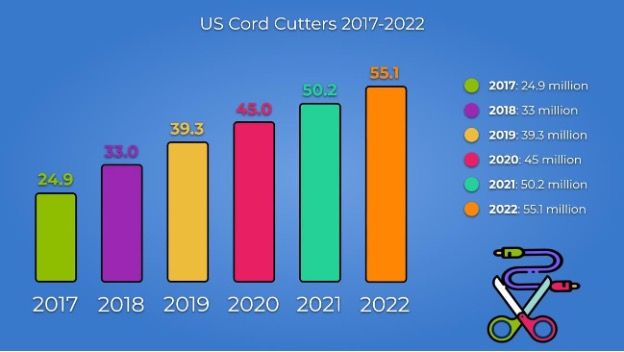
There was a big push a few years ago for people to “cord cut” and trade their overpriced Cable or Satellite Service in for an “internet-only” package. They would then only pay for the streaming services they used. People were inspired by stories of people who saved hundreds of dollars per month and declared that they had cut the cord. The chart below shows that the number people who have cut the cord has increased by more than twice since 2017.

Cutting the cord to only use a streaming service is especially helpful for younger workers trying to break into the workforce while paying off a large monthly student loan. The renters could get an apartment that had internet included, and then use the password to access Netflix, Hulu or other streaming services. Some people will gather a group of their friends to split the cost.
But good things do not last forever. Netflix hinted in 2019 that it knew “a small percentage” of their users shared passwords and was looking into ways to stop this. The price increases were assumed to have “baked in”, the expectation of password sharing. Netflix’s Basic Package has seen a 25% price increase over a 9-year period. The Standard and Premium Packages have experienced increases of 72% and 67%. In the same vein, users are sharing their passwords more often. In 2019, around 27% admitted to sharing their passwords, but now it’s more than 40%. (That equates to a nearly 50% increase in users who admit to this). Netflix has finally found a solution after a few long years of trying. After 31 days, if you log in using an IP address other than your primary IP address, there is now a 2-factor authentication that will allow you to continue streaming.
There is still a method to share your account with a family member or friend, but it’s unlikely that 10 friends will chip in a few dollars a month. It’s not a good idea to text the owner multiple times per month in order to confirm each participant’s updated login.
Not all streaming services, however, are the same. There are still a few streaming services which do not monitor password sharing. If someone has Peacock or Paramount+ on their streaming service, then they can easily share the password. Some of the larger names, like YouTubeTV and Apple TV+, have added “family share” features so that streamers can share their passwords with others who are not in the same household. It will be fascinating to see the outcome of streaming wars in this particular area. While waiting for the streaming wars to settle, cord cutters of certain services such as Netflix should inform their family members and friends that it’s time to get a Netflix login.

